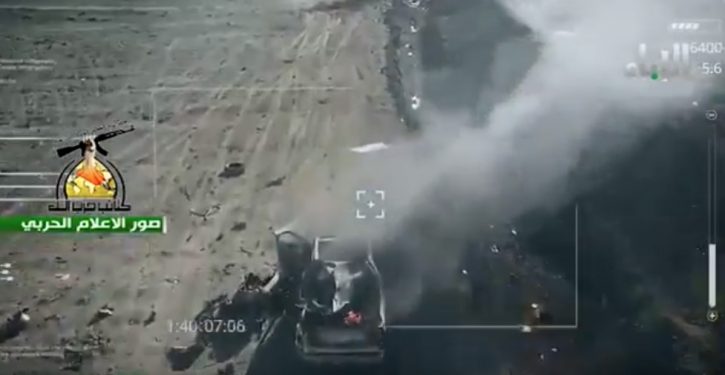
The Wall Street Journal reported last week that, according to U.S. officials, a drone-bomb attack on a Saudi oil pumping station on 14 May 2019 was launched not by Houthi fighters in Yemen but by Iran-backed Shia paramilitary forces (“militias”) in Iraq.
The attack, in other words, came from a direction different from the one originally posited. The U.S. officials cited in the report said also that the attack used assets different from the ones used previously by the Houthis. The officials apparently didn’t go into detail on this, but it’s likely that they fingered the Iran-backed militias in Iraq because the signature of the strike was similar to the assets Iran has been using to probe Israel’s defenses in the north.
The drone-bomb, in particular, may well have looked like the drone-bomb Israel downed back in February 2018, which approached Israeli air space from Syria and had originated from a compound south of Damascus controlled by Iran.
Will this presidential election be the most important in American history?
I call it a drone-bomb, incidentally, because it’s not an “armed drone” in the sense that it releases a missile or bomb of some kind and then departs. The drone itself is the delivery mechanism for the warhead. The reporting on the 14 May attack in Saudi Arabia has indicated that that’s what we’re talking about. The attempt against Israel involved the same apparatus: a drone-bomb.
There are multiple dimensions in which to analyze this development, and I will address only two here. One is the air defense problem for Saudi Arabia. It has been transformed overnight by this assessment.


Sudden multiplex air defense syndrome
That’s not just because threats have been demonstrated to emerge from a different geographic vector – although that figures into it. It’s because the low/slow-flier threat is one against which integrated Saudi defenses are not optimized, especially looking to the north. It’s also because, if Iran can use Iraq as a launchpad for attacks, what comes across the border may not remain limited to drones.
For some years now, since Saddam’s demise, the Saudis have been able to conceive of the threat from the north as involving Iran’s somewhat modernized ballistic missiles and combat tactical aircraft; i.e., the mix of former-U.S. and former-Soviet fighters and tactical bombers used by Iran, and launched from Iran. Given the relatively short distances from Iran to Saudi Arabia, military helicopters are a significant consideration as well.
For that threat, the standard operating capabilities of a Patriot missile battery, along with shorter-range air defense missile systems, can meet the requirements.
To deal with the Houthi threat from Yemen, the Saudis had to make some adjustments, which haven’t always been successful. To cut to the chase, the threat from Yemen looks somewhat more like the threat to Israel from Lebanon, Gaza, or southern Syria (although in the Saudi case, the distances can be much greater). Manned military aircraft are not meaningfully in the mix as the threat: shorter-range, less capable missiles and rockets are, and now drone-bombs – or, eventually, true armed drones.
Saudi capabilities against such a threat are a matter of what the arms supplier designs for. And the U.S. concept for defense against weapons like these isn’t about integrated national defense. Nor is Russia’s or China’s, for that matter – or France’s, Britain’s, etc.
Typical defenses, against the weapons that would be used against Saudi Arabia by paramilitary forces in southern Iraq, were developed for tactical, military force defense in a defined-battlespace situation. They weren’t designed to sit for months at a time, alerted but unused, so that in the case of rare need they could react to protect oil pumping stations or civil air terminals.
Against the lower-trajectory, lower- and slower-flying threat, these defenses, as designed for the national-armies problem, are soldier-intensive to operate, and limited in coverage and networked integration. They’re about fighting a military battlespace, not protecting the economic and civil assets of a nation.
But, significantly, Israel’s are about that civil protection mission. With her integrated air defense system, intricately layered below the “floor” at which U.S. and NATO defense concepts hand off regional or sector responsibilities to tactical forces with limited missions, Israel is the world leader in national defense against the class of weapon used to attack the Saudi pumping station.
And the difference between Israel’s vision and that of other arms designers is vividly illustrated by the new problem being presented to Saudi Arabia.
On the side of the Houthi threat, to the south, it has been possible to optimize defenses for that “below-floor” (or lower-tier) air and missile defense problem. But to the north, the Saudis would have to defend both the lower-tier and a higher-tier threat, because the longer-range missiles and military aircraft could still be a threat from Iran. (The higher-tier threat can and likely would also come over water, which presents additional considerations.)
Israel has faced exactly this combined, multi-tier threat for a number of years. Her defenses are expressly designed for it.
And Saudi Arabia now has to consider a similar multi-tier national defense threat from the north – in conjunction with a threat from the south that may well sprout an additional, higher tier.
Note as well that even if Iraq can be induced to make promises about denying access for Iran’s proxy adventures, this genie isn’t going back in the bottle. It’s already been Israel’s reality, because of Iran, for at least 20 years. The only thing that can remove it now as a defense concern for Saudi Arabia and the Gulf nations is regime-change in Iran. That’s the only thing that can keep it from spreading to other parts of the region as well, like Egypt and Jordan.
These points obviously cause the mind to shoot off in multiple directions at once. There won’t be space to explore them here.
Militarizing geography
But before moving on to the second major dimension of the problem, we’ll look at one more point about the new potential for a multi-tier threat to Saudi Arabia from the north. In brief, it’s this: the development of this kind of military problem is part of what I was talking about a couple of years ago, when I wrote about Iran’s pursuit of the land bridge to the Mediterranean “militarizing” the territorial space between the Zagros Mountains and the eastern borders of Syria and Israel. (At the link, scroll down for discussion related to the “territorial leverage” maps, also reproduced below.)


Until Iran-backed militias in Iraq launched a lower-tier aerial attack on Saudi Arabia, this military problem didn’t exist as something to be solved, with maps, territory, calculations, weaponry, and arrangements. Now it does.
The attack occurred because Iran’s pursuit of the land bridge both enables and necessitates the capability to hold Saudi Arabia at risk, and at risk from this vector. The land bridge itself is long, thin, and exposed (running across the Euphrates Corridor in Iraq and Eastern Syria; see source post for maps above). Iran will always have to defend it through Iraq, at least until – in the hazy caliphate of the apocalyptic future – it is no longer an “external” line of communication, but an internal one.
The mullahs are behaving exactly as they would if they intended to fully militarize their land bridge and all the territory adjacent to it. In the long term, it’s preparation for conquest. In the medium term, it’s gradual regularization of ordered posturings – weapon versus defense dynamics – among the affected parties. Saudi Arabia, it appears, has been initiated into the ranks of those parties — a development that was all but inevitable.
A new framework of military expectations among regional actors is as much a way to stabilize your land bridge as conquest or subjugation is. Iran may lose strategic surprise by encouraging such a framework to develop (i.e., the Saudis become much more alerted to the threat). But Iran still gains tremendously in operational preparation, and the shaping of expectations.
Sudden shock to the airspace usage
And that brings us to the second dimension. Michael Pregent previewed it in a tweet on Sunday, in which he reports that Iraq blocked U.S. access to Iraqi airspace during the Iran-backed attack on the Saudi pumping station.
Iraqi Government & military blocked U.S. access to Iraqi airspace during Kataib Hezbollah UAV attack on Saudi oil station.
GOI blocked US ISR after the attack as well.
GOI provided support to planned IRGC-QF-KH militia attack.
The GOI is complicit in KH attack on Saudi.
— Michael P Pregent (@MPPregent) June 30, 2019
I don’t know what Pregent’s source of information is for this, but it’s a credible claim. The wording isn’t entirely clear on how much we mentally connected this prohibition to a militia operation (by “Kataib Hezbollah”) going on at the time. We may have specifically wanted to operate in Iraqi airspace and been told no; we may have just been given a blanket prohibition covering a timeframe (e.g., a prohibition on launching UAVs or bringing aircraft in from Qatar), for which we didn’t connect the dots to the militia-launched attack until afterward. Perhaps we did recognize sufficiently at the time of the attack that there was something suspicious to look into, and Iraq stymied us.
But the bottom line, if Michael Pregent’s information is correct, is that we were operating under airspace authority constraints – which we do as a measure of good faith in maintaining our armed presence in Iraq. We are free to do what we must to go after ISIS, operate in Syria, and assist the Iraqi national army, but we don’t roam the airspace or the countryside doing whatever else we please.
That’s been the case wherever we’ve had forces deployed for forward defense and assistance missions (as opposed to full-blown war). It’s nothing we’re not used to. We work out a modus vivendi in each case.
But in Iraq, with Iran-backed militias down the road from our own forces, shooting rockets at us and now taking potshots at our regional partners, it’s going to be a problem.
The problem can’t be left unresolved. What Iran is counting on is that the U.S. will ultimately resolve it by pulling further out, rather than doubling down and forcing issues we’d have to force to shut Iran’s proxy enterprise down.
The temptation will be strong to simply see the issue in those terms – what’s politically sustainable for the U.S. national authorities – and leave it at that. But in the Middle East, it isn’t possible to leave it at that. The Middle East is where everything that intersects with this problem will become gradually more militarized and prepared for armed conflict.
Who can use the airspace for what, and what threats can be expected through the airspace, are key indicators in our modern world of regional militarization. In the recent past, it was possible to say that only Iran had a comprehensive vision of how to go to war and subdue the whole Middle Eastern theater. Territory, weapons, objectives, strategic narrative, who would shoot first and in which direction – that’s the “how” of going to war, and Iran’s IRGC has a vision for it.
But that’s changing as we speak. As long as the radical Islamic regime holds power in Iran, sending its proxies hither and yon to create new problems in other people’s airspace, the day is fast approaching when almost everyone else in the theater will have a polished up, resourced vision for how to go to war.
Such a situation will look a lot like the preludes to World Wars I and II. With all its unrest, that’s something the Middle East hasn’t actually seen for quite a long time.




